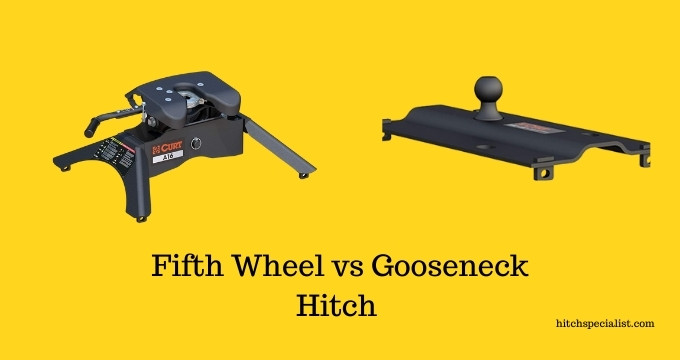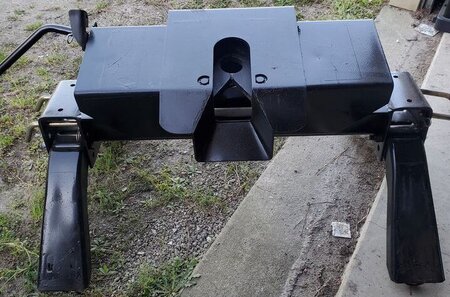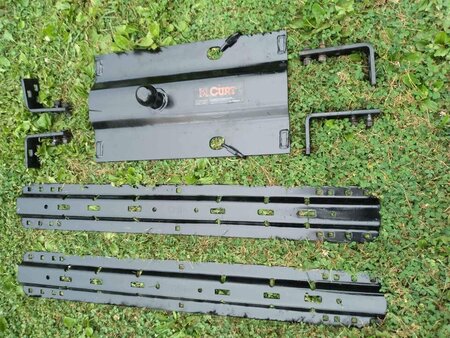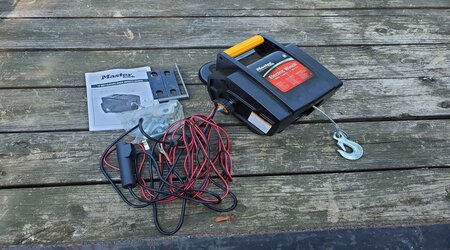Fifth wheel hitches and gooseneck hitches look alike, but these two hitches’ mechanism is different. Also, the installation system of both of these hitches is not the same. While one uses a kingpin, another uses a ball hitch. The coupling mechanism sets these two hitches apart. The towing capacity of a 5th wheel hitch and a gooseneck hitch isn’t the same either.

We understand it might get confusing for you to process much information at a time, so check out our fifth wheel hitch vs gooseneck hitch comparison below. We have compared these two hitches depending on different factors and our hitching experience.
What is a Fifth wheel hitch?

Ever wonder why it’s called a 5th wheel hitch in the first place? The history goes back to the 1800s when carriages included a fifth wheel to balance the carriage and care for animals or horses. Modern fifth wheel hitches have a U shape mount fitting and connect to a king pin.
A towing hitch system transfers the trailer’s weight over the rear axle or near the truck. However, it carries medium to heavy duty weight. Large campers, industrial trailers, semi trucks, travel trailers or wheel campers, recreation, and any kind of heavy duty trailer go well with this type of hitch.
What is a Gooseneck hitch?

A gooseneck hitch connects to your trailer’s coupler through the hitch ball and is positioned on the bed of the truck or tow vehicle. Its functions are similar to 5th wheel hitch excel: the whole weight distribution system is attached to the coupler and the style changes due to the truck bed. This type of hitch’s connection system begins from the truck’s midpoint and transfers weight over the gooseneck’s ball hitch rear axle.
However, gooseneck hitches are suitable for flatbed trucks, travel trailers, and horse trailers. Due to our long experience, we have used a gooseneck hitch for pickup trucks and commercial event trailers. But for newbies, we advise sticking to the general hitching rules.
Read: Andersen 5th wheel hitch for short bed truck
Fifth wheel hitch and gooseneck hitch comparison table
| Concern | Fifth wheel hitch | Gooseneck hitch |
|---|---|---|
| Maximum towing | 30,000lbs | 30,000lbs and more |
| Noise | Medium | High |
| Hitch type for Trailer | RVs, travel trailers | Tall trailers, livestock trailers, agricultural & horse trailers |
| Joint connection | Permanent | Temporary |
| Price | Expensive | Comparatively less expensive |
Coupling mechanism
Fifth wheel hitches attach to the bed of the towing truck. When the coupling is complete, the attachment point pushes the weight transfer connection over the rear axle of the hitch and picks up the tow vehicle. It increases your fifth wheel trailer’s coupler storage and weight capacity and provides more strength to tow heavy duty items and trailers. Also, the 5th wheel hitch attaches through a king pin and metal jaw.
On the contrary, Gooseneck hitches attach through the pick up bed and hitch balls. The trailer coupler also comes in the middle of the attachment point to ensure stability. It connects through the coupler and ball mount. The towing procedure of both of these hitches is quite similar, except gooseneck hitches transfer weight through the different bed styles and among the front axle.
Towing capacity
Towing capacity means the trailer’s weight and towing pickup trucks a fifth wheel trailer hitch can pull safely. The towing capacity of a gooseneck hitch starts from 25,000lbs to 30,000lbs and more. However, Curt offers gooseneck hitches that have a smooth towing ability of 25,000lbs weight capacity in general. B&W provides a capacity of over 27,000lbs+.
In the case of a 5th wheel hitch, the recreational towing capacity range starts from 16,000lbs to 30,000lbs. It can take up to 3,000lbs of tongue weight. PullRite provides a commercial towing capacity above 19,000lbs, and the Curt provides at max heavy duty towing of 30,000 lbs for their 5th wheel hitch models. Different brands offer different stable towing capacities according to their technologies and hitch models despite the generalized capacity.
Also read: How to towing a 5th wheel with an SUV?
Stability
Between gooseneck vs 5th wheel hitch, a fifth wheel camper is more stable than a gooseneck one. A 5th wheel hitch is permanently attached to the head plate and trailer frames by using a kingpin. The locking bars and jaws ensure that the fifth wheel trailer hitch doesn’t dislocate even in the most challenging wind or turns. So, the 5th wheel hitch is more stable, aligned and creates less sound than a gooseneck.
While gooseneck has a high towing capacity, but it has high noise. Gooseneck hitches are attached at the flatbed through the gooseneck ball temporarily, and often the ball might make the trailer go a 20 degree up and down. However, the temporary attachment provides easy access to function.
Design

Both of the hitches look like your regular hitch. The fifth wheel trailer has a square shape when it sits on the bed floor. Also, the 5th wheel hitch trailer tongue on the king pin provides it with a rectangle shape. These hitches are made of steel and corrosion-resistant powder coats to increase durability. You can tow RVS, recreation, and travel trailers with this.
Gooseneck hitches have a U-shaped safety chain above the plates. It is more significant than regular hitches, and the ball provides it a rounder look. These hitches include cargo boxes, trailer wiring, and metal beam plate. Gooseneck hitches are significant for commercial trailers and agricultural trailers.
Installation
Gooseneck trailer hitches are designed for professional use and heavy towing. After setting the gooseneck trailer measurement, you have to get the gooseneck trailer hitch installed to your long bed pick up with a clamper. Also, every time your tow weight changes, you have to reinstall and uncouple the whole gooseneck trailer hitch. If you are a professional, you should have no problem with this or try custom installed.
5th wheel hitches use king pin, ball mounts, and trailer frames to install. Also, a 2 inches receiver 5th wheel hitch should have no problem adjusting because most 5th wheels are universal in size. However, the permanent hitch attachment makes it complicated in the case of different tongue weights. Between the gooseneck and 5th wheel, the installation process of the fifth wheel hitch is complex.
Fifth wheel hitch Pros and Cons
| Pros | Cons |
|---|---|
| It includes a 45-degree anchor to the truck bed that ensures fast turning. | Trailer and pickup truck might have height clearance problems |
| Provides better grip and stability due to bumper attachment | You can’t access the loving quarters of your RV while driving |
| The towing capacity is higher than the standard ball hitch and also comes with multiple gross trailers towing capacity. | Expensive |
| Suitable for RVs, recreation, travel trailers, and fifth wheel campers. |
Gooseneck Hitch Pros and Cons
| Pros | Cons |
|---|---|
| Weight distribution pressure grows under truck frames and provides a fast grip on highways | Puts excessive pressure on the pinbox |
| Front and rear axles take weight on the top of the truck bed increasing your trailers life expectancy | Noisy ride than a fifth wheel trailer hitch |
| Sway resistance is stronger than a regular bumper hitch. | Complex to install |
| Suitable for tall trailers, livestock trailers RVs, and agricultural & horse trailers. |
Is it possible to convert the 5th wheel to a gooseneck hitch?

Yes, it is possible. There are two popular ways. You can install your 5th wheel camper using a coupler to the truck bed rail and secure it with hitch pins. But we recommend getting a Convert-A-Ball 5th wheel trailer gooseneck adapter or Reese adapter to convert the 5th wheel trailer hitch safely. Instead of using regular hitch pins, use the adapters instead. But always make sure the 5th wheel trailer towing capacity is legal for the gross trailer weight capacity.
Also read:
FAQS
What does the gooseneck adapter mean?
A gooseneck adapter means an extra gooseneck ball in safety chain anchors, which works as hitch balls to convert a fifth wheel hitch to a gooseneck trailer hitch.
How to pull a 5th wheel with a gooseneck?
First, drop the hitch ball or adapter inside the coupler and secure it. Afterward, use a latch handle and avoid any kind of leaning to safety chain loops pull completely to secure 5th wheel hitches.
Why can gooseneck tow more than 5th wheel hitches?
The extra coupler storage space and rear axle connection provide better weight displacement for truck bed towing capacity compared to a 5th wheel.
Does a gooseneck increase towing capacity?
No hitch can increase the towing capacity of your tow vehicle itself, but it can create an optimum truck bed weight distribution balance. This leads to a better towing capacity.
Can you pull a gooseneck with a 5.5 foot truck bed?
Yes, you can. However, we recommend attaching an extra trailer truck bed rail.
Can I pull 5th wheel hitches with my F150?
We do not recommend pulling a fifth wheel with a Ford F150. Technically, you can remove a fifth wheel hitch, but it can damage the ford truck bed in the long term.
Is a gooseneck better than a bumper pull?
A gooseneck is more stable than bumper pull due to the rear axle truck bed weight distribution.
Conclusion
The core difference between gooseneck vs 5th wheel hitch doesn’t make these hitches less significant. Because one is for professional use and one for regular use, sometimes, you might need both. For recreational purposes between the 5th wheel and gooseneck, we recommend getting a 5th wheel hitch. But for heavy duty towing, you should always go for a gooseneck.
Also read:




